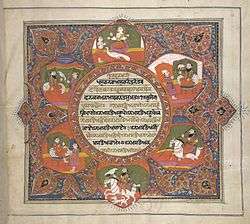Ugardanti
| Dasam Granth Dasam Granth - (ਦਸਮ ਗ੍ਰੰਥ ਸਾਹਿਬ)
|
| Banis |
| Jaap Sahib - Akal Ustat - Bachitar Natak - Chandi Charitar Ukat(i) Bilas - Chandi Charitar 2 - Chandi di Var - Gyan Parbodh - Chobis Avatar - Brahm Avtar - Rudar Avtar - Sabad patshahi 10 - 33 Swaiyey - Khalsa Mahima - Shastar Nam Mala - Charitropakhyan - Zafarnamah - Hikayats |
| Other Related Banis |
| Ugardanti - Bhagauti Astotar - Sri Kaal Chopai - Lakhi Jungle Khalsa - Asfotak Kabits - Sahansar Sukhmana - Vaar Malkauns Ki - Chandd - Chaupai Sahib - Tavparsadi Savaiye |
| History |
| Historical sources - Memorials |
| Various aspects |
| Idolatry Prohibtion |
Ugardanti (PA: ਉਗ੍ਰਦੰਤੀ) is a poetic composition written by Guru Gobind Singh, after the creation of the Khalsa Panth at Anandpur Sahib. The composition is present in Dasam Granth Bir Patna Sahib. The bani contains information about the creation of the Khalsa Panth, the dress code of the Sikhs, and is strictly against ritualism.[1]
Overview
Etymologically, Ugardanti is a feminine term made of two words, Ugar means Fierce and Danti means Tooth.[2] One having Fierce Tooth, is called Ugardanti. Guru Gobind Singh is praying to Ugardanti, writing various attributes of Ugardanti and asking for blessings of prospering of new Panth which is free from hypocrisy, ritualism, casteism, avtarvada, human worship and worship only one immortal god. In Gurmat, Fierce Tooth is explained as Hukam/Command/Will Power(Shakti) of God which tears off and destroys enemies.
In Bansavalinama Dasan Patshahian ka (1769), the author Kesar Singh Chibbar explains and quotes a few passages from Guru Gobind Singh's Ugardanti.[3]
In Hum Hindu Nahi(1898 ), the author Bhai Kahn Singh Nabha, believed that Ugardanti Bani was not written by Guru Gobind Singh but by Bhai Sukha Singh, a priest at Patna.[4]
Nihang Sikhs believe it to be written by Guru Gobind Singh and is part of their daily liturgy. It was and is read to inspire warriors to stand up for truth and righteousness in the face of tyranny and oppression. The Composition is divided into six verses called Chhands in which the syllables and the rhythm are arranged in a precisely controlled pattern. The Type of Chhandd used is Bhagvati Chhand.
References
- ↑ Ugardanti - Guru Gobind Singh(Chandd 5th and 6th)
- ↑ A practical Sanskrit dictionary with transliteration, accentuation, and etymological analysis throughout - Arthur Anthony Macdonell
- ↑ Bansavalinama Dasan Patshahian Ka - Kesar Singh Chibber
- ↑ Sikhs...We are not Hindus: Kahn Singh Nabha: ISBN 81-7205-379-7
External links
- Meaning of Ugardanti - Nihung Dharam Singh
- Ugardanti Bani Recitation - on Youtube
- Recitation by Giani Mehtab Singh - on Sikhnet
- Sri Dasam Granth Sahib: Questions and Answers: The book on Sri Dasam Granth Sahib
